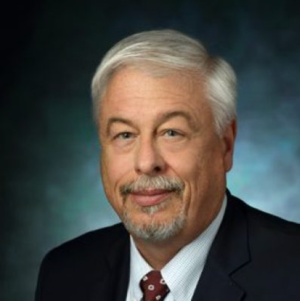David L. Roth, PhD, MA is a professor in the School of Medicine, Division of Geriatric Medicine and Gerontology. His research focuses on epidemiological studies of family caregiving, applied statistical analysis, and psychosocial influences on health and healthcare utilization. Dr. David Roth has been at the helm of the center as director for more than a decade. And now Dr. Roth is doing something the likes of which revered leaders, such as George Washington and Cincinnatus, have done—Dr. Roth is stepping down from power and making way for an emerging leader. Let’s learn more about him as a person as well as a professional.
Tell us about your background, education, and path to COAH.
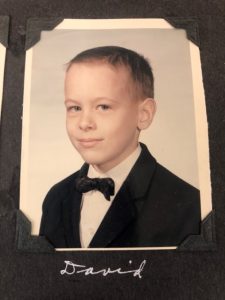
was born and raised in Minot, North Dakota. I have always had a dual fascination with numbers and with how the mind works. I combined those in my undergraduate studies, majoring in both mathematics and psychology at the University of North Dakota. I received a PhD in psychology from the University of Kansas and then took my first faculty position at the University of Alabama at Birmingham. My interests and skills in statistics and data analysis has led me into all kinds of interesting projects and collaborations, including into gerontology. In 2012, I applied for the COAH Directorship and was fortunate to be offered that position.
Your research focuses on applied geriatrics—analyzing data/statistics mostly on family caregivers and on the broader social resources of older adult populations. What about working with numbers appeals to you?
Quantifying behavioral and social factors is a big challenge, but this kind of rigorous measurement is critical for science to advance in these areas. Numbers convey a certain precision, but statistical analysis also incorporates the uncertainty of those numbers and the probabilistic nature of any conclusions we might draw. It’s fascinating to be able to work with colleagues and test hypotheses in research projects that have the potential to greatly improve the lives of older adults and their families.
You have about 270 original peer-reviewed research articles, 229 papers that have been cited 10 or more times, and you are the most cited researcher in the field of applied gerontology according to Google Analytics—currently cited more than 25K times. What advice do you have for junior investigators about becoming a prolific and well-cited researcher in this space?
I think too many researchers with quantitative or data analysis skills are trying way too hard to be as sophisticated as possible in their analytic approaches. This leads to papers with analysis methods that very few colleagues, not to mention the general public, actually understand. I try to emphasize that we want our readers to understand what we are doing and how we are testing our ideas. Let’s not overly complicate things if that is not necessary. Write as clearly as possible, and use conventional analytic methods when they are acceptable. There is no advantage to confusing people, or to conveying a “trust us” attitude on analyses that others don’t comprehend. If colleagues understand your work, they are more likely to cite it, and this increases the potential impact of your work.
You are most well-known for your 2015 paper “Informal caregiving and its impact on health: A reappraisal from population-based studies.” This and other papers led New York Times writers to interview you. Why was this paper so exciting?
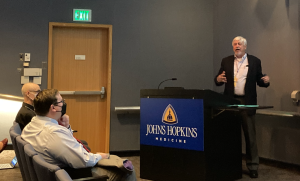
This paper challenged a common narrative in family caregiving research that the chronic stress of caregiving results in many serious threats to the caregivers’ health. A few early studies suggested that caregivers have elevated mortality rates, with mortality effects similar to those of smoking. However, many subsequent, large, population-based studies have not only failed to confirm the mortality threat, but actually found that caregivers tended to live longer than many comparison samples of non-caregivers. This has led to an increased attention on the positive aspects of caregiving, how caregiving is a type of social engagement, a form of volunteerism provided within your own family or social network. Caregiving can still be stressful, and caregivers deserve to have services to help them manage their responsibilities, but fortunately, some of the early dire predictions about the physical health consequences of caregiving appear to have been overstated. This paper played a major role in re-balancing the perspectives on the long-term health effects of caregiving.
Last year, you were named the M. Powell Lawton Award recipient from the Gerontological Society of America (GSA). This November, you will deliver the M. Powell Lawton lecture at the GSA Conference in Indianapolis, Indiana, on November 3rd, from 4:30 p.m. to 6:00 p.m. in Room 120-121. Please whet our appetite and give us a teaser about the topic you will discuss and its implications in applied gerontology.
The title of my address is “From Stressed Caregivers to Healthy Caregiving: The Implications of Balanced Perspectives and Updated Findings.” In the talk, I will briefly review the mortality findings discussed above and also review similar findings on inflammatory biomarkers. In both areas, the caregiving literature shows a bias pattern that is often found in other areas—particularly in the social and behavioral sciences, where early studies with relatively small sample sizes and alarming results are widely cited–whereas numerous subsequent studies with larger samples and better methods that don’t support the original alarming results are usually given much less attention. Science slowly corrects these biases over time, but it shouldn’t take as long as it often does.
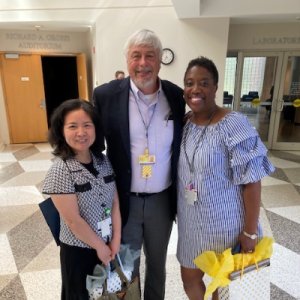
I heard you say that one of your favorite quotes about leadership is from Lao Tsu: “To lead people, walk beside them… As for the best leaders, people do not notice their existence. The next best, people honor and praise. The next, people fear; and the next, people hate…. When the best leader’s work is done, people say, ‘We did it ourselves!’” Tell us about a few examples in your personal or professional life where you think you lived up to this value.
As the Director of the Center on Aging and Health, I have tried to expand our breadth and to recruit and retain outstanding investigators. I have then tried to mostly stay out of their way as they do their exceptional work. They did do it themselves. If I had some small role in creating an environment where that could happen, and where they could expand their collaborative networks, then I have done a good job as a leader, but it’s really more as a facilitator than anything else.
This October, COAH turns 25, and you have been at its helm for more than a decade. What are a few of the most significant things to have developed at COAH over the past 10 years?
It’s hard to give a short answer to that. We have grown and expanded, while maintaining and advancing our historical strengths. We are well-known for our work on frailty, and rightfully so. That group continues to thrive and improve the lives of many older adults. We have established about 8 distinct working groups. We are much more active in analyzing national databases and examining trends in healthcare utilization using Medicare claims data as part of our Linked Administrative Data Resource (LADR). We have become very active in work on mobility, on international approaches to harmonizing cognitive aging data, on sensory changes associated with aging, and this is just a small sampling of the many innovative projects and collaborations that are ongoing. I apologize to the many productive and outstanding scientists we have whom I have failed to mention in this brief response.
If you didn’t have the position/career you’re in now, what would you be doing instead?
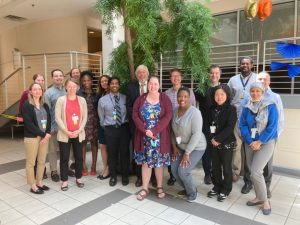
That’s a scary question. I have been blessed to have a rewarding and stimulating career. My biggest fear is boredom, but that never happens in my job. Research is always challenging and changing. It keeps you fresh and always striving to improve. I’m afraid that a lot of other careers, where you do similar things over and over again, would bore me.
Recently, you decided to step down as director of COAH. What will you do next?
That’s a good question. I will still collaborate, but spend more time away from work and enjoying the great outdoors. I love nature and being in the countryside.
Dr. Roth, this is an amazing track record of success! Thanks for sharing your thoughts on these professional matters.
Now, let’s turn to who you are when you’re not at work—and get a glimpse into your private world.
What is your earliest memory? How does it make you feel?
Pulling up in a pickup truck with my Dad to the new house my parents bought when I was 3 years old. It is a warm memory.
Is there any fun fact to know and tell you’d like us to know about your home life, family, where you grew up, etc.?
I came from a great family. A strong Catholic family. My parents were married for over 63 years, until my Dad passed away a few years ago in 2020 at the age of 90. My Mom is 86 and is still with us. She has a great sense of humor, and it is very fun to visit her, which I do every chance I get. Also, I have 3 great sisters, and a brother, too.
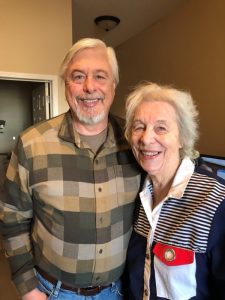
It sounds like your parents may have some secrets to healthy aging. With your expertise in this field, what have you observed about them to this extent?
They’re both from strong, midwestern farming families. They learned to work hard at an early age and to also take good care of themselves. When you were out on the farm 70-80 years ago, you had to be self-sufficient. They mastered that. They lived fairly simple, healthy lives, and had active lifestyles, not necessarily from exercise classes, but from everyday physical activities.
Tell us about when you think you first became aware of aging as an important health topic.
In graduate school, I received training in both neuropsychology and behavioral medicine. Both fields alerted me to the importance of aging, and to the importance of disease prevention and building optimal functioning over time. Then, when I started doing more collaborative work as an applied statistician, I became very impressed with the social dimensions of aging, the advantages of having a strong family, a robust social network, and the perils of social isolation. These interests grew and merged over time to create the scholar I am today.
What are some of your favorite, ordinary guilty pleasures?
-
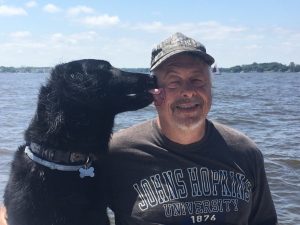
Jackson and Dr. Roth on the Magothy River TV show… I’m sure I’ve seen every Seinfeld episode multiple times, and still sometimes watch those reruns even now.
- Meal you cook… I love roasted duck, with acorn squash, a good green veggie, and an excellent bottle of red wine.
- Daytrip getaway destination… I take my boat out on the Magothy River frequently. There is a little island that I pull up to and let my dog swim and play. I have named it “Jackson island” after my dog.
- Quote… “The perfect is the enemy of the good.” Most attribute this to Voltaire, and I really agree with it. If we try to be perfect, we fail. We should try to be good, and always try to improve, but, as humans, we can never achieve perfection.
What is the top item on your bucket list?
To travel a lot more and see places in the world that I haven’t visited yet.
Where would you vacation if money was not an issue?
I have this fantasy to go camping in the Himalayas.
What advice did you receive as a young person that has served you well?
Finish what you started. Don’t quit on people. You want others to know that they can rely on you.
What advice do you have for young people today?
Be true to yourself. Try different things, partly to discover what you are good at, and what you enjoy doing, and then figure out a way to get paid to do those things as part of your career.
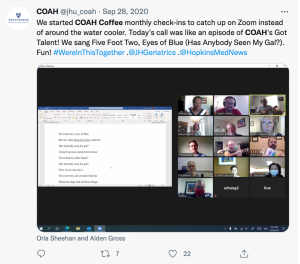
In my humble opinion, Dr. Roth treats the COAH team as members of an extended family brought together around core values of excellence and a commitment to inquiry into matters impacting older adults and their caregivers. Since COVID-19, he has found creative ways to bring his team together—whether it is for an occasional luncheon when pandemic conditions permitted, or virtually for periodic “COAH Coffee Hour” Zoom meetings to just banter and share what’s going on as real people. Ukulele, guitar, and even a xylophone was involved. To me, a hallmark of Dr. Roth’s leadership has been to cultivate cohesive camaraderie and to facilitate creative connections among passionate people whom he celebrates. He has consistently nominated COAH team members for various awards. As he gracefully vacates the director position, it is reassuring to know Dr. Roth is not leaving this wonderful community of people that he has mentored and nurtured, but rather he is becoming a different kind of collaborator and peer—and Dr. Roth will most certainly remain a champion of and among COAH champions.
You may also be interested in the following blogs by or about Dr. Roth:
- David L. Roth’s Recent Latent Variable Study Identifies Possible Inhibitory Pathway Contributing to Long-Term Caregiver Stress (Sept., 2022)
- Family Caregiving: An Essential Resource for Older Adults (Nov., 2021)
- David L. Roth to Receive the 2021 M. Powell Lawton Award from the Gerontological Society of America (Oct., 2021)
By Anthony L. Teano, MLA
Communications Specialist
